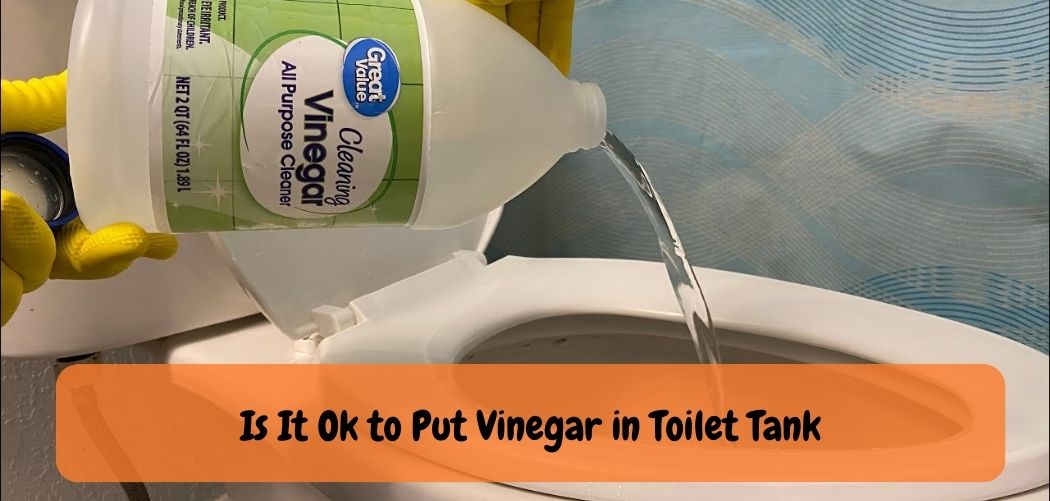Maintaining a clean and functional toilet is essential for every household, but cleaning the toilet tank can be a tricky task. Many people resort to using commercial cleaning products, but others wonder if they can use natural alternatives like vinegar.
Vinegar is a common household item known for its cleaning properties, and some people swear by its effectiveness in cleaning toilet tanks. However, some concerns have been raised about whether vinegar can damage the toilet tank or affect its components.
In this article, we will explore whether it is okay to put vinegar in the toilet tank and provide some tips on how to safely use vinegar for cleaning your toilet tank.
Put Vinegar in Toilet Tank Safety Guide
Keeping a clean and functional toilet tank is essential for maintaining good hygiene and preventing plumbing issues. While commercial cleaning products are readily available, many people prefer to use natural alternatives like vinegar. Vinegar is a common household item that is known for its cleaning properties, but is it safe to use in a toilet tank? In this informative guide, we will explore the benefits and risks of using vinegar in a toilet tank and provide some tips on how to safely use it.
Benefits of Using Vinegar in a Toilet Tank

1. Natural cleaning properties: Vinegar is a natural cleaning agent that can effectively remove stains and buildup in the toilet tank.
2. Cost-effective: Vinegar is an inexpensive alternative to commercial cleaning products, making it a budget-friendly option for those who want to save money.
3. Environmentally friendly: Vinegar is non-toxic and biodegradable, making it an environmentally friendly alternative to harsh chemicals.
Risks of Using Vinegar in a Toilet Tank
- Corrosion: Vinegar is an acid that can corrode metal parts in the toilet tank, such as the bolts or flapper valve.
- Rubber and plastic parts damage: Vinegar can damage the rubber and plastic components of the toilet tank, causing them to deteriorate or break down.
- Odor: While vinegar can remove odors from the toilet tank, it can also leave a strong vinegar smell behind.
How to Safely Use Vinegar in a Toilet Tank?
1. Dilute the vinegar:
Mix equal parts of water and vinegar to create a diluted solution that is less likely to cause damage to the toilet tank’s components.
2. Avoid using on rubber or plastic parts:
Do not use vinegar on rubber or plastic parts of the toilet tank, as it can cause damage. Instead, use a non-acidic cleaner or simply use water to clean these parts.
3. Do not let it sit for too long:
Avoid letting the vinegar solution sit in the toilet tank for an extended period. Instead, scrub the tank with the solution and then flush it out with water.
4. Ventilate the area:
When using vinegar, ensure that the area is well-ventilate to avoid inhaling the strong odor.
How Long Can You Leave Vinegar in a Toilet Tank?

Vinegar is an effective and natural cleaner for your toilet tank, but you should aware of how long it can stay in the tank before needing to replaced. The answer depends on what type of vinegar you are using. White vinegar has a shelf life of about three years, so it should last in the toilet tank for this amount of time if left undisturbed.
Apple cider vinegar, however, only has a shelf life of two years or less and will need to be changed out more frequently than white vinegar. You’ll want to make sure that any excess vinegar is flushed from the bowl after each use since acids like those found in vinegars can damage some types of toilets over time as well as corrode metal parts inside the tank.
Also Read: Can You Pour Bleach in Toilet Tank?
What Does Putting Vinegar in Your Toilet Tank Do?

Adding vinegar to your toilet tank is a great way to keep it clean and running smoothly. It helps reduce bacteria growth, prevents mineral buildup from hard water, and removes odors. Vinegar works as a disinfectant by killing odor-causing bacteria in the tank.
Additionally, vinegar’s acidic properties help dissolve any minerals that may have built up due to hard water use. When added regularly (once or twice per month) it will also prevent future buildups of debris and grime that can cause clogs and other plumbing issues if left unchecked. Furthermore, it helps keep the inner workings of your toilet in good condition by reducing corrosion on parts such as the flapper valve seal or flush handle mechanisms.
Lastly, adding vinegar to your toilet tank can be an effective deodorizer – simply pour a cup into the bowl before bedtime for fresher smelling mornings!
How Much Vinegar Do You Put in the Back of a Toilet Tank?

When it comes to cleaning your toilet tank, vinegar is a great option. It’s safe for use on all types of surfaces and can help remove limescale and mineral deposits. But how much do you need?
Generally speaking, the amount of vinegar that should use in a toilet tank depends on the size of the tank. For most standard tanks, about one gallon of white distilled vinegar is sufficient. Start by pouring the vinegar into an empty bucket or container, then slowly pour it into the back of the toilet bowl where it will fill up the tank without spilling over onto nearby flooring or fixtures.
Let sit overnight before flushing in order to allow time for any buildup inside to dissolve completely and rinse away with fresh water when done soaking. Finally, make sure to also clean out any other parts like flush valves or float mechanisms as well which may have built-up grime from years of use; this will ensure maximum effectiveness when using vinegar for cleaning purposes!
Put VINEGAR into your TOILET and WATCH What Happens! (Bathroom Cleaning Hacks)
Conclusion
Using vinegar to clean your toilet tank can be an effective and natural alternative to commercial cleaning products. However, it is essential to use vinegar safely and avoid any potential damage to the toilet tank’s components.
Remember to dilute the vinegar and avoid using it on rubber or plastic parts of the tank. With proper use, vinegar can help you maintain a clean and functional toilet tank without any harm to the environment or your health.
As always, if you have any concerns about using vinegar in your toilet tank, consult a professional plumber for advice.










